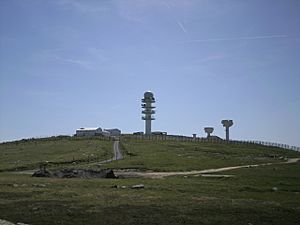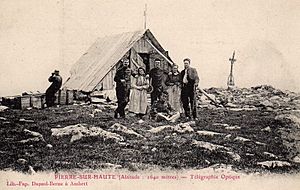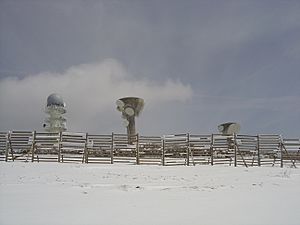Pierre-sur-Haute military radio station facts for kids
Quick facts for kids Pierre-sur-Haute military radio station |
|
|---|---|
| Station hertzienne de Pierre-sur-Haute (French) | |

The military radio station of Pierre-sur-Haute. Two military towers are pictured: the Télédiffusion de France relay tower is in the centre, with the living quarters, and a helipad.
|
|
| Coordinates | 45°39′11″N 3°48′30″E / 45.6531°N 3.8084°E |
| Type | Radio tower complex |
| Site information | |
| Controlled by | France |
| Site history | |
| Built | 1961 |
| Materials | Concrete, steel |
The Pierre-sur-Haute military radio station is a special place in France. It covers about 30 hectares (74 acres) on top of a hill. This site is used for important communications by the French armed forces. It has been in use for a very long time, since 1913.
The station is located in two French towns, Sauvain and Job. The border between the Rhône-Alpes and Auvergne regions goes right through the site. There are three towers there. The tallest one is 55 meters (180 feet) high. It belongs to a civilian company called Télédiffusion de France.
In April 2013, something interesting happened. The French intelligence agency (DCRI) asked Wikimedia France to remove the French Wikipedia article about this station. But another Wikipedia editor in Switzerland quickly put it back online. Because of this event, the article became very popular. This is a good example of the Streisand effect. The Streisand effect is when someone tries to hide information, but it ends up making that information even more widely known.
Contents
History of the Station
The story of Pierre-sur-Haute began in 1913. Back then, it was a semaphore telegraph station. This was a way to send messages using signals from arms on a tower. It was a small stone building with the semaphore on top.
Later, in 1961, during the Cold War, NATO asked the French Army to build a new station here. It was part of a big network of 82 communication points across Europe. This network was called the ACE High system. The Pierre-sur-Haute station, also known as FLYZ, helped relay messages. It connected to stations in the south (Lachens) and the north (Mont-Août).
The NATO radio station used special equipment to send voice and telegraph signals. This network stretched from Turkey all the way to the Arctic Polar Circle in Norway. In 1974, the French Air Force took over the station. By the late 1980s, the old system was slowly replaced. The large dish antennas, which people called Mickey's ears, were replaced in 1991. They were replaced with the two antennas you see today.
What the Station Does
The Pierre-sur-Haute station is managed by the French Air Force. It is connected to the Lyon – Mont Verdun Air Base, which is about 80 kilometers (50 miles) east. This station is one of four important radio stations along France's main communication line. It is always in touch with the other three stations: Lacaune, Henrichemont, and the Rochefort air base.
The station's main job is to send messages for military operations. For example, if France's nuclear weapons (called force de dissuasion) needed to be used, the order might pass through this station.
Since 1994, the station has been part of a group that manages air surveillance, information, and communication systems. From 2006, it has been run by the Joint Directorate of Infrastructure Networks and Information Systems.
Buildings and Facilities
The station is located on a 30-hectare (74-acre) site. It sits between the towns of Sauvain and Job. The border between the Loire and Puy-de-Dôme departments runs through it. A tall fence made of wood and metal surrounds the entire area.
The Towers

There are three towers at the site. The tallest one is 55 meters (180 feet) high. It is a civilian telecommunication tower owned by Télédiffusion de France. This tower has a special dome on top called a radome. Inside the dome is a radar system for air traffic control. This radar helps guide airplanes. It started working in 2009 but sometimes has problems because of heavy snow.
The other two concrete towers belong to the military. These towers are 30 meters (98 feet) high. They have been used for sending and receiving radio signals since 1991. These military towers are built very strong. They are designed to survive the blast of a nuclear explosion.
Other Buildings and Tunnels
Some buildings at the station are used as garages. Others are living quarters for the staff. They have kitchens, dining rooms, and bedrooms. These buildings are connected by tunnels. The tunnels are about 400 meters (1,300 feet) long in total. This helps the staff move between buildings without walking through deep snow in winter. About 20 people work at the station. They include electricians, mechanics, and cooks.
Underground Facilities
The most important part of the station is underground. This section is used for sending out communications. Messages from the towers are analyzed here. Then, they are sent to their correct destinations very quickly.
This underground area is very well protected. It has defenses against dangerous substances like chemicals or radiation. It also protects against electromagnetic pulses. An electromagnetic pulse is a burst of energy that can damage electronic equipment. The facility uses a Faraday cage to block these pulses. A Faraday cage is like a shield that stops electrical energy. The rooms inside are also kept at a slightly higher air pressure. This helps prevent outside dirt or harmful things from getting in. The facility also has its own water and power supplies. This means it can keep working even if outside services are cut off.
See also
 In Spanish: Estación de radio militar de Pierre-sur-Haute para niños
In Spanish: Estación de radio militar de Pierre-sur-Haute para niños




